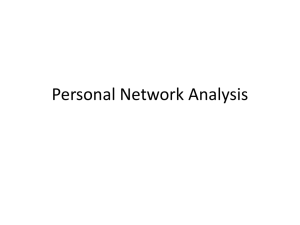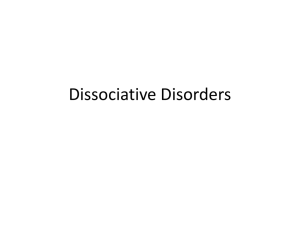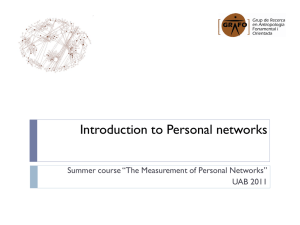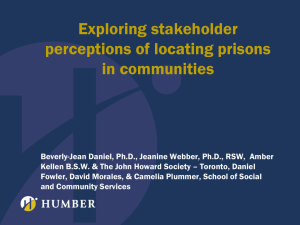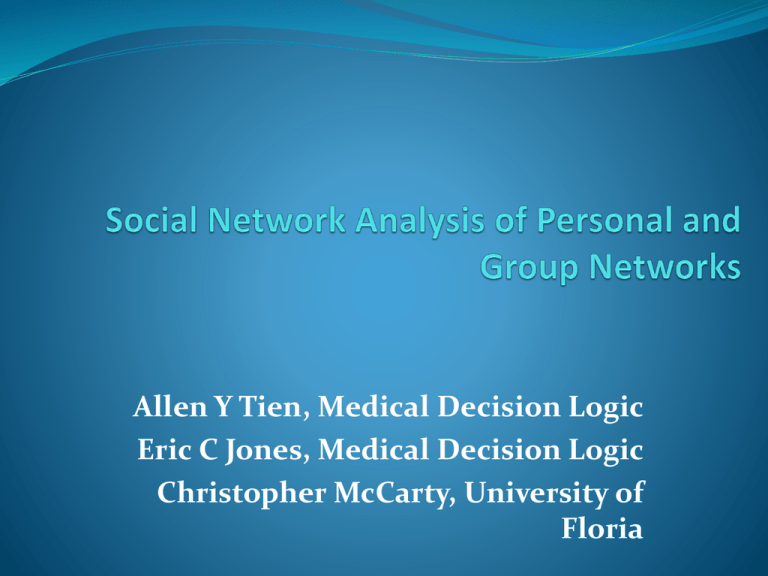
Allen Y Tien, Medical Decision Logic
Eric C Jones, Medical Decision Logic
Christopher McCarty, University of
Floria
The Plan for Today
Introduction to social networks. (1 hr)
1.
Why investigate social networks?
ii. History and definition.
iii. What exactly are we measuring?
i.
Designing a social network study (goals, design,
sampling, bias & name generators issues). (½
hr)
2.
3. EgoNet workshop (1 ½ hrs)
–
–
–
–
Introduction to EgoNet screens.
Collect your own 25-alter ego network.
Demonstrate visualization interview.
Demonstrate aggregation and modeling.
4. Research with EgoNet and VisuaLyzer (1 hr)
1. Introduction to Social
Networks (i).
Why investigate social networks?
Example of a Research Design in Social and
Behavioral
Sciences
Age
Education
Income
Number of
cigarettes
smoked daily
Height
Weight
Independent variables
Dependent variable
A scientist can gather information on a sample of
500 respondents and attempt to predict their
smoking behavior using variability across a variety of
demographic & biological variables.
Conclusion
Age
Education
Income
Number of
cigarettes
smoked daily
Height
Weight
Independent variables
Dependent variable
The scientist concludes that age, education and
income are good predictors of number of cigarettes
smoked daily, but weight and height are not good
Social
Influences
Social scientists think that some outcomes or
dependent variables are influenced by social
factors.
For example, it is commonly accepted that
adolescents start smoking because of their peers.
Since peer influence is not easily observed directly,
social scientists design questions that can be used
as proxies for peer influence.
Questions (Proxy Measures)
Do your parents smoke? Parents)
Do most of your friends smoke? (Friends)
Have any of your friends ever offered you cigarettes?
(Offered)
Predictive
Power of Social Influence
Age
Education
Income
Parents
Friends
Offered
Independent variables
Number of
cigarettes
smoked daily
Dependent variable
Researchers have discovered that these measures
expain part of the variance that was previously
unexplained by age, education or income.
Questions about These Results
Would knowing more details about the social
influences around a person provide greater
explanatory power?
If so, what questions could we ask to acquire these
details?
Does social network analysis provide the kind of
details we’re looking for?
Social influence intervention
National Cancer Institute funded 15 year, $15 million
study
40 school districts, 20 experimental, 20 control
Schools spanned grades 3 to 12
Endpoints were daily smoking at grade 12 and 2 years
after high school
n = 8,388 students
Intervention
Skills for identifying social influences
Skills for resisting social influences
Information for correcting erroneous perceptions
Motivation to want to be smoke free
Promoting self confidence
Enlisting family support
Results of intervention
Differences in daily smoking at grade 12 between the
control and experimental group was not statistically
significant
Differences by gender were not significant
Differences between the two groups 2 years after high
school are not statistically significant
Daily smoking prevalence was higher 2 years after high
school
Why didn’t this work?
1.
Maybe social influences don’t matter
2.
Social influences matter, but they are impossible to
control
3.
Social influences matter, but the intervention was
too generic
Factors that make social influence nongeneric
Variability in the characteristics of influential people
Variability in the structure of the network of
influential people
Variability in the characteristics of structurally
important people
1. Introduction to Social
Networks (ii).
History and definition
A bit of History …
Moreno’s sociometry
The “Manchester School” (Gluckman, Mitchell)
personal networks of tribal people in the new cities of the
Cooperbelt (also India, Malta, Norway)
messiness of culture change, mobility,
multiculturalism
social networks as an alternative to Structural-
Functionalist Theory
A bit of History …
INSNA & Computers &
Interdisciplinarity, NScience
American Sociology (1976)
Graph Theory (e.g. Harary 1963)
Manchester School (1954-1972)
Moreno Sociometry (1934)
Red externa o
extendidad
For instance …
Gossip network …
Mónica
Mrs.
Mutwale
(Epstein, 1957)
Nicholas
=
Besa
Phiri
Ponde
Misma tribu o grupo lingüístico
Dirección del chisme
Misma escuela
Vecinos
Misma iglesia
East York …
Vecinos
Inmediata
(Wellman, 1999)
Familia
Extendida
Persona
de East
York
Lazos íntimos
activos
Lazos no íntimos
activos
Amigos
Compañeros de trabajo
Munich … (2010)
Personal network of a
Peruvian migrant in
Munich
Perú
Vecindario
Trabajo
Alemania
Familia
Amigos
Two kinds of social network analysis
Personal (Egocentric)
Whole (Complete or
Sociocentric)
Effects of social context on
individual attitudes,
behaviors and conditions
Collect data from respondent
(ego) about interactions with
network members (alters) in
all social settings.
Interaction within a socially or
geographically bounded group
Collect data from group members
about their ties to other group
members in a selected social
setting.
Not a Simple Dichotomy
The world is one large (un-measurable) whole network
Personal and whole networks are part of a spectrum of
social observations
Different objectives require different network “lenses”
Personal Networks: Unbounded Social Phenomena
Example: Predict
depression among
seniors using the
cohesiveness of their
personal network
• Social influence spans social domains
• Network variables are treated as
attributes of respondents
• These are used to predict outcomes
(or treated as outcomes)
Whole network: Bounded Social Phenomena
Focus on
social
position
within the
space
Social or geographic space
Example: Predict depression among seniors using social
position in a Retirement Home
Overlapping personal networks: Bounded and
Unbounded Social Phenomena
Use overlapping
networks as a proxy
for whole network
structure, and identify
mutually shared
peripheral alters
Social or geographic space
Example: Predict depression among seniors based on social
position within a Retirement Home and contacts with alters
outside the home
A note on the term “Egocentric”
Egocentric means “focused on Ego”.
You can do an egocentric analysis within a whole
network
See much of Ron Burt’s work on structural holes
See the Ego Networks option in Ucinet
Personal networks are egocentric networks within
the whole network of the World (but not within a
typical, theoretically bounded whole network).
Summary so far
When to use social networks
If the phenomenon appears to have social influences whose
mechanisms are not well understood
When to use whole networks
If the phenomenon of interest occurs within a socially or
geographically bounded space.
If members of the population not independent, tend to interact.
When to use personal networks
If the phenomena of interest affects people irrespective of a
particular bounded space.
If the members of population are independent of one another.
When to use both
When members of the population are not independent and tend
to interact, but influences from outside may also be important.
1. Introduction to
Social Networks (iii).
What are we measuring?
Social networks are unique
No two networks are exactly
alike
Social contexts may share
attributes, but combinations
of attributes and ties make
each one different
We assume that differences
across respondents influence
attitudes, behaviors and
conditions
Content and shape of a social network may be
influenced by many variables
Ascribed characteristics
Chosen characteristics
Sex
Income
Age
Occupation
Race
Hobbies
Place of birth
Religion
Family ties
Location of home
Genetic attributes
Amount of travel
How a whole network is formed
Formal responsibilities
Ascribed characteristics
(e.g.,sex) and chosen
characteristics (e.g.,
hobby) may interact with
culture to effectively screen
potential alters
Ascribed characteristics
may influence chosen
characteristics, but not the
reverse
How a personal network is
formed
Social responsibilities
Ascribed characteristics
(e.g.,sex) and chosen
characteristics (e.g.,
hobby) may interact with
culture to effectively screen
potential alters
Ascribed characteristics
may influence chosen
characteristics, but not the
reverse
Types of social network data
Composition: Variables that summarize the
attributes of people in a network.
Proportion with a given responsibility.
Proportion who are women.
Proportion that provide emotional support.
Structure: Metrics that summarize structure.
Number of components.
Betweenness centralization.
Subgroups.
Composition and Structure: Variables that capture
both.
Sobriety of most between alter.
Is person with highest degree & betweenness the same?
Personal Network Composition
Attribute summary file
Name
Closeness
Relation
Sex
Age
Race
Where Live
Year_Met
Joydip_K
5
14
1
25
1
1
1994
Shikha_K
4
12
0
34
1
1
2001
Candice_A
5
2
0
24
3
2
1990
Brian_N
2
3
1
23
3
2
2001
Barbara_A
3
3
0
42
3
1
1991
Matthew_A
2
3
1
20
3
2
1991
Kavita_G
2
3
0
22
1
3
1991
Ketki_G
3
3
0
54
1
1
1991
Kiran_G
1
3
1
23
1
1
1991
Kristin_K
4
2
0
24
3
1
1986
Keith_K
2
3
1
26
3
1
1995
Gail_C
4
3
0
33
3
1
1992
Allison_C
3
3
0
19
3
1
1992
Vicki_K
1
3
0
34
3
1
2002
Neha_G
4
2
0
24
1
2
1990
.
.
.
.
.
.
.
.
.
.
.
.
.
.
.
.
.
.
.
.
.
.
.
.
Social network composition variables
* Proportion of social network that
are women …
* Average age of network …
* Proportion of strong ties …
* Average number of years knowing each
other …
Percent of alters from host country
(personal networks)
36 Percent Host Country
44 Percent Host Country
• Percent from host country captures composition
• Does not capture structure
Social Network Structure
Adjacency matrix
Joydip_K
Shikha_K
Candice_A
Brian_N
Barbara_A
Matthew_A
Kavita_G
Ketki_G
.
.
Joydip_K
1
1
1
1
0
0
0
0
.
.
Shikha_K
1
1
0
0
0
0
0
0
.
.
Candice_A
1
0
1
1
1
1
1
1
.
.
Brian_N
1
0
1
1
1
1
1
1
.
.
Barbara_A
0
0
1
1
1
1
0
0
.
.
Matthew_A
0
0
1
1
1
1
1
1
.
.
Kavita_G
0
0
1
1
0
1
1
1
.
.
Ketki_G
0
0
1
1
0
1
1
1
.
.
.
.
.
.
.
.
.
.
.
.
.
.
.
.
.
.
.
.
.
.
.
.
.
.
.
.
.
.
.
.
.
.
.
Social Network Structural Variables
Average degree centrality (density)
Average closeness centrality
Average betweenness centrality
Core/periphery
Number of components
Number of isolates
Components
Components 1
Components 10
• Components captures separately maintained groups (network structure)
• It does not capture type of groups (network composition)
Average Betweenness Centrality
Average Betweenness 12.7
Average Betweenness 14.6
SD 26.5
SD 40.5
• Betweenness centrality captures bridging between groups
• It does not capture the types of groups that are bridged
Sociocentric network data collection
Matrix representing ties between network members
Observed data (e-mail transactions, telephone calls,
attendance at events)
Ask network members to evaluate tie (Scale of 0 to 5,
how well do you know, how close are you)
Structural measures
Three network components
Beth is most degree central
Amber is most between central
Thomas and Kent are structurally equivalent
Removal of David maximizes network
fragmentation
Some applications of sociocentric network
analysis
Structure within organizations
Structure between organizations
Terrorist networks
Diffusion of innovations
Some applications of sociocentric network
analysis
Structure within organizations
Structure between organizations
Terrorist networks
Diffusion of innovations
Interventions?
People often have little
People often have a lot of
choice over who is in a
whole network
choice over who is in their
personal network (but
they may not know it)
By showing people how
the whole network
functions, changes can be
made to benefit the group
Individuals may use the
knowledge of their social
position to their advantage
Based on ascribed
characteristics and chosen
characteristics, some people
may make conscious choices
about the type of people
they meet and who they
introduce
Many variables of interest to social scientists
are thought to be influenced by social context
Social outcomes
Personality
Acculturation
Well-being
Social capital
Social support
Health outcomes
Smoking
Depression
Fertility
Obesity
How could we intervene in this network?
2. Designing a
Social Network Study
Goals, design, sampling, bias & name
generators issues.
Make sure you need a network study!
Personal network data are time-consuming and
difficult to collect with high respondent burden
Sometime network concepts can be represented
with proxy questions
Example: “Do most of your friends smoke?”
By doing a network study you assume that the
detailed data will explain some unique portion of
variance not accounted for by proxies
It is difficult for proxy questions to capture
structural properties of networks
Sometimes the way we think and talk about
who we know does not accurately reflect
the social context
Neighbors
Close friends
Former job
diverse acquaintances
My family and me
distant family
Hairdresser
Friends & acquaintances
from the workplace
friends
people from the workplace
acquaintances from the
workplace
Family in
Serbia
Friends
here from
Bosnia
Neighbors
Friends
Husband
family
FAMILY
WORK
FRIENDS
Prevalence vs. Relationships
Estimate the prevalence of a personal-network
characteristic in a population
Sampling should be as random and representative as possible.
Sample size should be selected to achieve an acceptable margin of
error.
Example: Sample 411 personal networks to estimate the proportion
of supportive alters with a five percent margin of error.
Analyze the relationship between personal-
network characteristic and something you want to
predict?
Sampling should maximize the range of values across variables to
achieve statistical power.
Example: Sample 200 personal networks of depressed and 200 of
not depressed seniors to test whether the number of isolates
predicts depression.
Steps to a personal network survey
Part of any survey
1. Identify a population.
2. Select a sample of respondents.
3. Ask questions about respondent.
Unique to personal network survey
4. Elicit network members (name generator).
5. Ask questions about each network member (name
interpreter).
6. Ask respondent to evaluate alter-alter ties.
7. Discover with the informant new insights about her personal
network (through visualization + interview).
Selecting a Population
Choose wisely, define properly – this largely will determine
your modes of data collection and the sampling frame you
will use to select respondents.
Certain populations tend to cluster spatially, or have lists
available, while others do not
Race and ethnicity may seem like good clustering
parameters, but are increasingly difficult to define.
Modes of Survey Research
Face-to-face, telephone, mail, and Web (listed here in
order of decreasing cost)
The majority of costs are not incurred in actually
interviewing the respondent, but in finding available
and willing respondents
Depending on the population there may be no
convenient or practical sample frame for making
telephone, mail, or email contact
Sample Frames
This can be thought of as a list representing, as closely as
possible, all of the people in the population you wish to
study.
The combination of population definition and survey mode
suggests the sample frames available.
Sample frames may be census tracts, lists of addresses,
membership rosters, or individuals who respond to an
advertisement.
Example from acculturation study
GOAL: develop a personal-network measure of
acculturation to predict migrant behavior outcomes
CHALLENGE: develop an acculturation measure not
dependent on language and/or geography
POPULATION: migrants in the US and Spain
SURVEY MODE: face-to-face computer assisted
SAMPLE FRAME: Miami, NYC, Barcelona; n=535
recruitment via classifieds, flyers, and snowballing
Questions about Ego
These are the dependent (outcome) variables you will predict using network
data, or the independent (explanatory) variables you will use to explain
network data and for controls
Dependent
Depression
Smoking
Income
Independent
Number of moves in lifetime
Hobbies
Controls
Age
Sex
Be aware that it is common to find relationships between personal network
variables and outcomes that disappear when control variables are introduced
Example models from acculturation study
Prob>|t| for models using average degree centrality
Variable
Health Depression Smoking Children
Average Degree Centrality
(density)
0.2546
0.0487
0.0026
0.1516
Sex (1=Male)
0.0001
0.9235
0.0009
0.0299
Generation (1=First)
0.6672
0.0230
0.0412
0.4297
Age
0.4674
0.0051
0.0747
0.4934
Skin color (1=White)
0.5495
0.7051
0.3473
0.4874
Marital status (1=Never Married)
0.0451
0.2639
0.1571
0.0001
Employed (1=No)
0.3921
0.0127
0.2389
0.2501
Education (1=Secondary)
0.0001
0.0073
0.2439
0.0004
Legal (1=Yes)
0.1428
0.2537
0.1330
0.3468
R Square
0.0732
0.0619
0.0677
0.2543
Writing Questions
Be mindful of levels of measurement and the
limitations/advantages each provides (nominal, ordinal,
interval and ratio)
Ensure that your questions are valid, brief, and are not
double-barreled or leading
You can ensure survey efficiency by utilizing questionnaire
authoring software with skip logic
Name generators
Only ego knows who is in his or her network.
Name generators are questions used to elicit alter
names.
Elicitation will always be biased because:
Names are not stored randomly in memory
Many variables can impact the way names are recalled
Respondents have varying levels of energy and interest
Variables that might impact
how names are recalled
The setting
Serial effects to naming
Home
Alters with similar
Work
names
Alters in groups
The use of external aids
Phone
Chronology
Address book
Frequency of contact
Facebook
Duration
Others sitting nearby
Ways to control (select) bias
Large sample of alters
Name 45 alters.
Force chronology
List alters you saw most recently.
Diary.
Force structure
Name as many unrelated pairs and isolates.
Force closeness
Name people you talk to about important matters.
Attempt randomness
Name people with specific first names.
Limited or unlimited
Many reasons respondents stop listing alters.
They list all relevant alters.
Memory.
Fatigue.
Motivation.
The number of alters listed is not a good proxy for
network size
There are other ways to get network size.
RSW.
Network Scale-up Method.
Structural metrics with different numbers of alters
requires normalization.
Sometimes is preferable to have respondents do the
same amount of work.
Names or initials
Some Human Subjects Review Boards do not like alter
names being listed.
Personal health information.
Revealing illegal or dangerous activity.
With many alters ego will need a name that they
recognize later in the interview.
First and last name is preferable or WilSha for William
Shakespeare.
Personal Network Peculiarities
Respondents may want to list dead people, long-lost
friends, TV characters, or celebrities
They may have compromised memories
You may want to limit alters to people who provide
respondents specific kinds of support
Acculturation Example
Our prompt (pretested) for freelisting 45 alters:
“You know them and they know you by sight or by name.
You have had some contact with them in the past two years,
either in person, by phone, by mail or by e-mail, and you
could contact them again if you had to.”
Still, migrants often didn’t understand that alters who
didn’t live in the host country could be listed
Other Elicitation Options
You may want to let alters keep listing names to get a
network size variable, but it is hard to know why people stop
listing alters (fatigue, memory, etc.)
More likely, you will want less alters named, since personal
network data collection is very intensive
You can use specialized prompts to more randomly elicit
fewer alters or only ask questions about every Nth alter
named, but keep in mind that eliciting fewer alters will
unintentionally bias your sample
Asking Questions about Alters
(Name Interpreters)
• Try to avoid having respondents make uninformed
guesses about people they know
• Still, some researchers argue it is really the
respondents’ perception of their alters that influences
their own attitudes and behaviors
• Figuring out how well a person knows their alters and
the nature of their relationships is the most
challenging interpretive activity
How well do you know…
Find out long the respondent has known the alter
(duration) as well as their frequency and main mode of
contact
Research suggests that tie strength is best assessed using
questions about closeness
People tend to be less close to people they do not like,
even though they may know a lot about them
Asking how respondents know someone is also helpful –
“How did you meet?” (school, work, etc.)
Acculturation Example
45 alters
x 13 questions about each
= 585 total items
Demographics (age, sex, CoO, distance, etc.)
Closeness of respondent/alters relationship (1-5)
How they met (family, work, neighbor, school)
Communication (modes, intimacy, trust )
Do they smoke?
Analyzing Compositional Data
Create a summary of each variable for each
respondent, keeping in mind their levels of
measurement
Merge the summarized variables onto the
respondent-level data to explain characteristics of
respondents
Measure the extent to which alter characteristics
match the respondent (ego correspondence,
homophily)
You can then perform frequencies, cross tabulations,
and create dummy variables to be used in regressions
Effect of respondent characteristics on predicting
migrants’ smoking
Respondent Characteristic
% Does Not Smoke
% Smoke
Sex***
Individual Attributes: age, sex, employment, etc.
Male
67 (200)
33 (99)
Female
80 (189)
20 (47)
Employment**
Full Time
68 (103)
32 (49)
Part Time
85 (87)
15 (15)
Unemployed
73 (127)
27 (47)
Retired
83 (10)
17 (2)
Self Employed
54 (19)
46 (16)
Seasonal
72 (43)
28 (17)
Acculturation
Level 1
77 (150)
23 (45)
Level 2
71 (148)
29 (60)
Level 3
69 (72)
31 (32)
Level 4
65 (17)
35 (9)
Level 5
100 (2)
0 (0)
Effect of compositional variables on migrant smoking
Composition Variable
Proportion of alters with listed tie strength
Level 1
Level 2
Level 3**
Level 4
Level 5
Proportion of alters of listed sex
Male***
Female ***
Proportion of alters that are confidantes
Yes***
No***
Proportion of alters that are smokers
Yes***
No***
% Does Not Smoke
% Smoke
.12
.24
.23
.18
.22
.10
.26
.27
.17
.20
.52
.47
.57
.42
.39
.61
.47
.53
.19
.81
.35
.65
Asking about Ties Between
Alters
This is a time consuming process… however,
If you limit yourself to network composition, you assume
the effects of social context on attitudes, behaviors and
conditions are more about who occupies a personal
network than about how they are structurally arranged
around the respondent
Still, keep in mind the exponential nature of your chosen
alter sample size…
that they have a relationship independent of you?”
Questions about Accuracy
Some researchers do not believe respondents can report
alter-tie data with any accuracy… We do
It is easier for respondents to report on the existence of ties
between alters they know from different social domains
than on ties between people they may not know well from a
single domain
Personal networks are more attuned to the larger structures
of different groups and bridging between groups than subtle
interactions within groups
Some Network Structural
Procedures
• Multi-dimensional scaling is a procedure used to determine the
number and type of dimensions in a data set.
• Factor Analysis (also called principal components) is a procedure that
attempts to construct groups based on the variability of the alter ties.
Also used in survey research.
• Cluster analysis is a family of statistical procedures designed to group
objects of similar kinds into categories.
• Quadratic Assignment Procedure is a bootstrap method used to
determine whether two networks are different.
Acculturation Example
Network Structural Metric
Does not smoke
Smokes
Average degree centrality***
29
23
Average closeness centrality
142
149
Average betweenness centrality
1.5
1.7
Components
1.4
1.5
Isolates*
4
6
• migrants with denser networks are more likely to smoke
• but wait… does smoking cause the structural differences
or do the structural differences cause smoking?
Some Network Structural
Metrics
• Degree Centrality is the number of alters any given alter is directly
•
•
•
•
•
•
•
•
connected to.
Degree Centralization is the extent to which the network structure
is dominated by a single alter in terms of degree.
Closeness Centrality is the inverse of the distance from that alter
to all other alters.
Closeness Centralization is the extent to which the network
structure is dominated by a single alter in terms of closeness.
Betweenness centrality for a given alter is the number of geodesics
(shortest paths) between all alters that the alter is on.
Betweenness Centralization is the extent to which the network
structure is dominated by a single alter in terms of betweenness.
Components are connected graphs within a network.
Cliques are maximally complete subgraphs.
Isolates are alters who are not tied to anybody else.
Incremental improvement in R square by adding variable in model with
acculturation and control variables
Variable
Health
Depression
Smoking
Children
0
0.0031
0.0018
0.0035
Alter sex
0.0019
0.0024
0.0012
0.0011
Frequency of alter contact
0.0042
0.0169
0
0.0043
Where alters live
0.0003
0.0072
0.0029
0.004
0
0.0005
0.0004
0.0003
Proportion family
0.0045
0.0019
0.0059
0.0235
Alter age
0.0116
0.0006
0.0025
0.0298
Alter race
0.0012
0.001
0.0023
0.0183
Alter as confidante
0.0005
0.0033
0.0267
0.0003
Alter smoking status
0.0001
0.0202
0.1296
0.0046
Average degree centrality
0.0035
0.0065
0.0151
0.001
Average closeness centrality
0.0012
0.0076
-0.001
-0.0002
Average betweenness centrality
0.0012
-0.0001
0.0021
0.0025
Isolates
0.0033
0.0015
0.0046
-0.0003
Components
0.0051
0.0072
-0.0008
0
Core size
0.0033
0.0035
0.0095
0.0019
Strength of tie
Where alters were born
Combining Composition and
Structure
Treating each variable independently assumes composition
and structure do not interact
You can only combine structural variables with
compositional variables when they are calculated at the level
of the alter…
Centrality Scores
Density
whether or not the alter is an isolate
Acculturation Example
Does Not Smoke
.07
Smokes
.13
.08
.18
Does Not Smoke
Smokes
Most degree central alter
does not smoke
83
57
Most degree central alter
smokes
17
43
Proportion of smoking
alters that are strong ties
Proportion of smoking
alters that are confidantes
Personal Network Visualizations
Hand-Drawn
vs.
Structural
other
oth er
B erlin’s form er bo yfriend
Florencia
Flor encia
B erlin
B e rlin
Father’s fam ily
B ar celo na fr ie nd s +
clo se kin
M other’s fam ily
H alle friends
m other's
fam ily
H a lle
fa ther 's
fam ily
B erlín
C ollege friends
B arcelona friends
fam ily
Some Notes on Visualization
• Network visualization lets you quickly identify relationships
between several compositional and structural variables
simultaneously
• Visualization should be guided by research question
• The way different software algorithms places nodes with
respect to one another is meaningful
• Nodes and ties can often be sized, shaped, and colored in
various ways to convey information
Moroccan migrant in Barcelona – age 36
Dominican migrant in Barcelona – age 46
3. Workshop with EgoNet
Egonet
Egonet is a program for the collection and analysis of
egocentric network data.
It helps you create the questionnaire, collect data, and
provide global network measures and matrices.
It also provides the means to export data that can be used
for further analysis by other software.
EgonetQB Design Screenshot
EgonetQB Design Screenshot
Egonet Design Screenshot
Egonet Design Screenshot
When you
create a new Study, the database
Study
design
The study design is saved in a file named EgoNet.gdb.
The study has four modules, Ego description, Ego-
Alters’ name generator, Alters description and AlterAlter relationship.
Break!!
Analysis in Egonet
Two Classmates’ Networks
Analysis in VisuaLyzer
Thanks!
of Acculturation and its Application to
Immigrant Populations in South Florida and
Northeastern Spain
Develop a measure of acculturation based on personal
network variables that can be used across geography
and language
Visualization of the networks of two sisters
Label = Country of origin, Size = Closeness, Color = Skin color,
Shape = Smoking Status
• Mercedes is a 19-year-old second
generation Gambian woman in Barcelona
• Laura is a 22-year-old second generation
Gambian woman in Barcelona
• She is Muslim and lives with her parents
and 8 brothers and sisters
• She is Muslim and lives with her parents
and 8 brothers and sisters
• She goes to school, works and stays
home caring for her siblings. She does
not smoke or drink.
• She works, but does not like to stay
home. She smokes and drinks and goes
to parties on weekends.
Table 1. Unstandardized means of personal network characteristics per
identification (N = 271).
Percentage of French/Wolof
Percentage of migrants
N cohesive subgroups
Homogeneity of subgroups
Density
Betweenness centralization
Average freq. of contact
Average closeness
Percentage of family
* p < .05; ** p < .01.
Generic
F
Ethnic- exclusive
Ethnic-plural or
transna-tional
13.2
29.6
1.6
60.9
41.2
16.2
4.0
2.1
36.3
25.2
31.9
2.2
63.5
28.9
20.6
4.3
2.1
30.4
26.2
36.3
2.1
56.3
30.6
18.8
4.0
2.1
35.2
12.3**
2.1
5.2**
1.7
9.5**
3.2*
1.8
0.9
3.1*
Social and Cultural Context of Racial
Inequalities in Health
Observation: Rates of hypertension are much
higher among African Americans than other racial
groups
Hypothesis: Hypertension is a function of stress
which is caused in part by the compositional and
structural properties of the personal networks of
African Americans
62-year-old African American female with PhD, Income >
$100,000, Skin Color=Dark Brown
Egocentric author networks
How does composition and structure of the egocentric
co-author network affect scientific impact (the hindex)?
Example
1: Low
H, Low co-authors
H-index
1
# co-authors
2
Affiliation
Univ Milan,
Dipartimento Sci
Terra, I-20134
Milan, Italy
Sampled article
Late Paleozoic and
Triassic bryozoans
from the Tethys
Himalaya (N
India, Nepal and S
Tibet)
Example
2: Low
H, High co-authors
H-index
1
# co-authors
Affiliation
Sampled article
12
Clin Humanitas,
Med Oncol &
Hematol Dept, I20089 Rozzano,
MI, Italy
Chemotherapy
with mitomycin c
and capecitabine
in patients with
advanced
colorectal cancer
pretreated with
irinotecan and
oxaliplatin
Example
3: High
H, Low co-authors
H-index
31
# co-authors
Affiliation
Sampled article
14
Catholic Univ
Korea, Dept
Pharmacol, Seoul,
South Korea
Establishment of a
2-D human
urinary proteomic
map in IgA
nephropathy
Example
4: High
H, High co-authors
H-index
35
# co-authors
Affiliation
Sampled article
67
Katholieke Univ
Leuven, Oral
Imaging Ctr, Fac
Med, B-3000
Louvain, Belgium
Development of a
novel digital
subtraction
technique for
detecting subtle
changes in
jawbone density
Analysis
Individual
Aggregated
Promise
&
Challenges
greater ability to assess causation
greater ability to infer dynamic network change
high likelihood of respondent attrition
more alters may be added to networks over time
Interviewers need to keep asking egos the same questions
about their alters – increasing burden
Norma Time 1
Norma Time 2
Personal Network Visualization as a Helpful
Interviewing Tool
Many respondents become very interested when they first
see their network visualized
By using different visualizations, you can ask respondents
questions about their social context that would otherwise
be impossible to consider
why they confide in some alters more than others
if they’d introduce an alter from one group into another
Why isolates in their network aren’t tied to anyone
Thanks!
5. Introduction to Vennmaker
Vennmaker
It is a new software tool for participative
visualization and analysis of social networks.
Provides a user friendly mapping layout and GUI.
Can compare different individual perspectives and
visualizing changes in networks over time.
Allows for automated personal network interviews.
Combines aspects of quantitative and qualitative
network analysis in real-time (audio recording).
Deceased!
2 „conflicts“
2 regions of departure
0 own-ethnic
contacts in GER
Intercultural
working
relationships
Final
remarks
…
In the last decade the studies using the personal
network perspective has increased a lot …
Chris McCarty and Jose Molina plan to put all data
gathered during the last years in a joint Observatory
open to the scientific community:
http://personal-networks.uab.es
Relation categories in Thailand
Objective: Discover mutually exclusive and exhaustive
categories in a language for how people know each
other to be used on a network scale-up survey
instrument
Procedure 1: Twenty one respondents freelist in Thai
ways that people know each other
Procedure 2: Twenty one respondents list 30
people they know and apply 26 most frequently
occurring categories
colleague
ปอนด์
นุช
เพ็ ญ
พี่ยู
หมี
อาจารย์นิ
อาจารย์อมรา
พี่นด
ิ
มด
พี่จม
ุ๋
พี่ภา
พี่จวิ่
น ้าช่วย
อาจารย์มานพ
วรา
โจ ้
สุทป
ี
พี่ยาว
พี่เกด
ส ้ม
เกด
พี่เหว่า
เอ๋ย
ปิ ง
เล็ก
น ้าม่อน
ป้ าขวด
นุ ้ย
household
0
1
0
0
1
1
1
1
1
0
1
1
1
0
0
0
1
0
0
0
1
1
0
0
0
0
0
0
neighbour
1
0
0
0
0
0
0
0
0
0
0
0
0
0
0
0
0
0
0
0
0
0
0
0
0
0
0
0
sport club/ park
0
0
1
0
0
0
0
0
0
0
0
0
0
0
0
0
0
0
0
0
0
0
0
0
0
0
0
0
meeting
0
0
0
0
0
0
0
0
0
0
0
0
0
0
0
0
0
0
0
0
0
0
0
0
0
0
0
0
0
1
0
0
1
1
1
0
1
1
1
1
0
1
0
0
0
1
0
0
0
0
1
1
0
0
0
0
relatives temple/ church
same community
1
0
0
0
0
0
0
0
0
0
0
0
0
0
0
0
0
0
0
0
0
0
0
0
0
0
0
0
0
0
0
0
0
0
0
0
0
0
0
0
0
0
0
0
0
0
0
0
0
0
1
0
1
0
0
0
0
0
0
0
0
0
0
0
0
0
0
0
0
0
0
0
0
0
0
0
0
0
0
0
0
0
0
0
Affiliation from all respondents
Graph of relationship between
knowing categories

